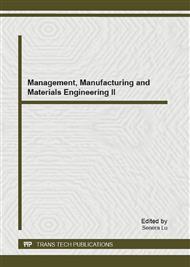[1]
Kopicky R. J,Berg M. J, Legg L, Dasappa V,Maggioni C. Reuse and Recycling:Reverse Logistics Opportunities. Council of Logistics Management,Oak Brook,IL.
Google Scholar
[2]
Moritz Fleischmann,Jacqueline M. Bloemhof-Ruwaard,Rommert Dekker,Erwin van der Laan,Jo A. E. E. van Nunen,Luk N. Van Wassenhove. Quantitative Models for Reverse Logistics:A Review European. Journal of Operational Research,Volume103,Issue 1,16 November 1997,P. 1~17.
DOI: 10.1016/s0377-2217(97)00230-0
Google Scholar
[3]
Hokey Min,Hyun Jeung Ko,Chang Seong Ko. A Genetic Algorithm Approach to developing the multi-echelon Reverse Logistics Network for Product Returns. Omega,Volume 34,Issue1,January 2006,P. 56~69.
DOI: 10.1016/j.omega.2004.07.025
Google Scholar
[4]
Der-Horng Lee,Meng Dong. Dynamical Network Design for Reverse Logistics Operations under Uncertainty[J]. Transportation Research Part E: Logistics and Transportation Review. In Press,Corrected Proof,Available online 11 October (2008).
DOI: 10.1016/j.tre.2008.08.002
Google Scholar
[5]
Joseph Sarkis. A Strategic Decision Framework for Green Supply Chain Management[J]. Journal of Cleaner Production,Volume11,Issue 4,June 2003,P. 397~409.
DOI: 10.1016/s0959-6526(02)00062-8
Google Scholar
[6]
Yasutaka Kainuma,Nobuhiko Tawara. A Multiple Attribute Utility Theory Approach to Lean and Green Supply Chain Management[J]. International Journal of Production Economics,Volume 101,Issue 1,May 2006,P. 99~108.
DOI: 10.1016/j.ijpe.2005.05.010
Google Scholar
[7]
Wang Changqiong. Research on Green Logistics Meaning, Characteristics and Strategic Value [J]. China's Circulation Economy, No. 3, 2004, 12~14.
Google Scholar
[8]
Wang Changqiong. Evaluation System of Logistics Sustainable Development[J]. Economic Management, 2005, No. 1, 38 ~40.
Google Scholar
[9]
Zhao Yiping, Zhu Qinghua, Xie Yingdi. The Dynamic Mechanism of System of Green Supply Chain management [J]. Research of Technology Management, 2008, No. 2, 152 ~154.
Google Scholar
[10]
BaoYun. Evaluation System Logistics Sustainable Development Based on AHP [J]. Logistics Technology, 2007, No. 1, 8 ~11.
Google Scholar
[11]
Hui Yurong, Dong Qianli. Evaluation of Logistics Sustainable Development Based on Data Envelopment [J]. Beijing Jiaotong University (social science), 2008, No. 3, 65 ~ 69.
Google Scholar
[12]
SunPeng, Luo Xinxing. Analysis about Synergy Factor of Modern Regional Logistics Based on Multi-dimensional Space [J]. Soft Science, April 2010, 79~ 82.
Google Scholar


